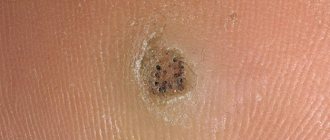Due to prolonged mechanical impact, which is caused by friction or pressure on the foot area, a person develops a callus. This neoplasm does not pose a threat to health and life. Growths are considered a common problem and can be easily removed using medications or hardware techniques. Despite the discomfort from the pathological element on the skin, many do not seek timely medical help, which can lead to an inflammatory process. Let's look at the reasons why the callus became inflamed and what to do in this situation?
Causes of watery calluses
A water callus on the toe, heel, or foot occurs as a result of wearing tight shoes.
Most often, traumatic friction on the surface of the skin is created by decorative membranes, toes, heels or hard elements of new shoes. The occurrence of water callus is promoted by:
- tight shoes;
- sweaty feet;
- swelling of the limbs;
- shoes made of artificial materials;
- sand or other abrasives on the surface of the skin.
The mechanism of formation of water calluses
As a result of pressure or friction on the surface of the skin, redness, swelling and peeling of the epidermis occurs. The resulting cavity (bubble) is quickly filled with intercellular fluid. The occurrence of dropsy is a physiological process of protecting the body from the penetration of staphylococcal or streptococcal infections into injured skin.
At the slightest touch or pressure, the water callus causes significant pain. If friction against the surface of the skin continues, the filled bubble bursts, leaving a red, weeping wound on the inflamed area.
Signs of water blisters infection:
- temperature increase;
- purulent discharge from the callus;
- expansion of the boundaries of redness;
- change in color of water callus;
- the appearance of yellow flaky areas around the callus;
- pain in the inflamed area even without mechanical impact.
Folk remedies
Good results in the fight against inflammatory phenomena during infection of all types of calluses are obtained by using folk remedies in combination with pharmaceutical drugs.
You can relieve inflammation and cure calluses by using the most effective folk recipes:
- Aloe .
The juice and leaves of the plant are used. A cut leaf of a three-year-old aloe is kept for at least two days in the refrigerator. Then squeeze out the juice, or use the whole leaf. Prepared aloe must be applied to the inflamed area, covered with film and secured with a bandage.
- Chamomile .
An infusion is prepared from chamomile flowers, which is added to warm water for a bath. Keep your feet in such a bath for at least 15 minutes. Next, wipe your feet thoroughly and lubricate the inflamed area with Vishnevsky ointment. The final stage is to protect the treated area with a bactericidal patch.
- Propolis . You can make a propolis tincture yourself, or purchase it at a pharmacy. Then use it for compresses, alternating with treating the inflamed area with Vishnevsky ointment, Streptocide ointment, or Levomekol ointment.
The absence of positive dynamics of treatment or the appearance of signs of suppuration indicates the need for an immediate visit to the doctor. In most cases, the wound is cleaned and treated with antibiotics.
Diagnostics
Water calluses on the feet are diagnosed as follows:
- an examination is carried out by a dermatologist
; - You may need additional consultation with a rheumatologist
, podologist or
orthopedist
.
Calluses should not be confused, for example, with inflammatory changes in joints, pinched nerves, inflammation of hangnails, genetically determined keratinization of the skin, and warts.
When diagnosing water callus, it is important to determine whether the patient has concomitant diseases. For example, varicose veins, diabetes mellitus, venous insufficiency, neuritis and so on.
Treatment with medications
Minor inflammation that began at an early stage of the formation of growths can be relieved using the following means:
- a patch impregnated with a special preparation that has an analgesic, anti-inflammatory, and softening effect. The keratinized area of tissue softens, the skin returns to its normal state, and you can clean the foot from the callus using ordinary pumice;
- lubricating the inflamed area with iodine, brilliant green solution, Miramistin or Baneocin;
- ointments that have a disinfecting effect . These include ichthyol ointment, Vishnevsky ointment, Levomekol, Lekar cream.
You can also use Japanese socks for calluses. Before using them, be sure to read the instructions for use.
You can remove the callus yourself after eliminating the inflammatory phenomena only at the initial stage of formation of the neoplasm. Consultation with a specialist is required.
How to cure water blister
What to do if a water callus has formed on your leg? Small dropsies quickly go away on their own. To protect against injury, it is recommended to cover the inflamed area with a bactericidal plaster for 1-2 days and not wear tight shoes.
Large water calluses on the feet cause aesthetic and physiological discomfort and therefore require treatment. The optimal therapeutic method is opening or puncture. It is recommended to pierce the callus on the first day the blister appears.
Is it possible to pierce an inflamed callus yourself? In order to avoid wound infection, all manipulations should be carried out with clean hands and a sterile needle. If it is not possible to ensure sterility and thorough surface treatment, it is better to open the dropsy in a doctor’s office.
Self-puncture of a watery callus on the leg is carried out as follows:
- Treat the callus and surrounding skin with an antiseptic solution (alcohol, brilliant green, hydrogen peroxide, iodine).
- Take a sterile needle from an injection syringe. If you don’t have such a needle, you can heat a regular pin over a fire or disinfect it in medical alcohol.
- The needle is inserted into the water callus parallel to the surface of the skin (on the side of the bladder). It is not recommended to pierce water blisters on the legs in the central part because... this can injure the bottom of the callus.
- For good outflow of fluid, it is necessary to make 2-3 punctures, while maintaining the integrity of the walls of the bladder.
- When the punctures are made, the water bubble is slowly pressed against the surface of the skin with a sterile bandage or gauze to squeeze out all the liquid present in the cavity.
- A bactericidal patch is applied to the dropsy. The walls of the released bladder cover the inflamed skin inside the callus, protecting the wound from infection.
- The patch or bandage on calluses must be changed 2 times a day and removed at night.
There are cases when, after a few days, the water callus is again filled with intercellular fluid. Then the puncture should be repeated.
Water bladder suppuration
If there was suppuration in the callus, it is necessary:
- open the water callus and remove the infected bladder walls;
- treat the wound with an antiseptic;
- apply antibiotic ointment to the weeping wound;
- cover the affected area of skin with a gauze pad and adhesive tape.
The inflammatory process and suppuration in the water callus, which are accompanied by an increase in body temperature and the growth of the area of redness, are localized on an outpatient basis, in the surgical office. The specialist will clean the wound area, apply a bandage with drainage if necessary, and prescribe antibacterial therapy.
Treatment of water callus with folk remedies
- A proven folk method for treating water blisters on the legs and arms is salt baths. A warm saline solution (1 teaspoon per 1 liter of water) or a strong solution of potassium permanganate disinfects well and softens the callus, accelerating healing.
- Aloe juice is considered another effective remedy. Aloe pulp is a natural antiseptic that relieves inflammation and accelerates healing. A plant leaf cut along the surface or a swab soaked in aloe juice is placed on the water bladder. This compress is fixed with a bandage and changed every 4-6 hours. To treat a small callus, you can use regular plantain. A leaf washed in cold water must be mashed until the juice appears and applied tightly to the callus. After 4-5 hours, the application is repeated.
- Lemon has a good antiseptic and softening effect. For water blisters, it is recommended to apply an application of grated pulp and lemon peel to the damaged area of skin and hold for up to 5 minutes. It will be enough to apply 2 compresses during the day so that the next day the pain goes away and the callus decreases.
If the water bubble bursts on its own
Due to excessive pressure or mechanical damage, the water callus may burst. Spontaneous opening is accompanied by painful discomfort and burning. The open wound should be disinfected and covered with a bactericidal bandage. If after a few days the area of redness around the callus increases and suppuration is noticeable, such symptoms indicate infection of the burst callus and require immediate contact with a specialist.
Water calluses on the soles require special attention. If the skin on your feet is rough and prone to calluses, dropsy can become a painful ingrown callus.
What to do?
The callus is inflamed: what to do if it was not possible to avoid infection, and a visit to the doctor has to be postponed for some time?
- It is necessary to take painkillers and anti-inflammatory drugs . Ibuprofen, which combines both properties, is suitable as such a remedy.
- Next, you need to isolate the affected area using a protective bandage made of cotton wool and adhesive tape. A special hydrocolloid patch designed to speed up healing is also suitable. The hydrocolloid patch not only reduces the friction load, but also absorbs liquid if the bubble opens.
- Additional treatment is carried out using a three percent solution of hydrogen peroxide , as well as dusting with streptocide powder. You can use Baneocin, Tyrosur, or another ointment containing an antibiotic.
- Do not put off visiting a doctor even if the measures taken have significantly slowed down the inflammatory process.
Prevention
To avoid the appearance of calluses on your hands and feet, you must follow the following rules:
- When working with a risk of skin chafing, wear special protective gloves.
- Shoes should be comfortable and breathable. If it rubs, use a band-aid. Try to avoid high heels for daily wear.
- If you experience excessive sweating, you can use talc.
- True to size socks, made from natural fabrics.
- Maintain a normal body weight.
- Perform hygiene measures for your feet.
In cases where a callus has already appeared, it is necessary:
- Treat it with an antiseptic.
- Eliminate the influence of the external environment: use a bactericidal adhesive plaster; for wet calluses, a hydrocolloid plaster is effective, reducing friction and also absorbing liquid in case of accidental opening of a blister.
Follow preventive measures, start treatment on time, do not allow inflammation to develop - this way you will maintain the health of the skin of your feet and be able to avoid problems associated with calluses.
Complications
Incorrect or untimely treatment of calluses leads to adverse consequences:
- An abscess is a purulent melting of tissue with the formation of a cavity.
- Phlegmon is a diffuse inflammation of the subcutaneous tissue.
- Osteomyelitis is a disease accompanied by an inflammatory process in bone tissue.
- Sepsis is blood poisoning with the possible formation of ulcers in distant areas and organs (septicopyemia). This is a serious complication, the outcome of which is often fatal.








